Ever had one of those days where all you needed was just a few more winks of sleep but life just wouldn’t grant you that sweet serenity? Well, believe it or not, your feathered friends can relate! If you’ve noticed your charming avian companion transforming into a bit of a peck-ish grump lately, it might be time to ask yourself: does my bird need more sleep? As odd as it may seem, bird sleep needs are not so different from ours, and a good night’s rest profoundly affects bird health and sleep patterns.
Sure, your bird isn’t staying up late to binge-watch the latest series or wrapping up a last-minute work report, but disruptions like late-night TV sessions can be a real dream-stealer for them. Just imagine trying to catch some ZZZs with headlights flashing through your windows constantly – not so cozy, right? So yes, your feathery friend needs its beauty sleep too, not just for its mood but also to keep its immune system in tip-top shape.
In fact, your pet bird needs 9 – 11 hours of sleep each night! If your bird could talk human, it might even sassily remind you that a happy bird is a well-rested bird! And remember, while strategically placing their cage in the quietest nook of your home at night might not add to your interior design credibility, it certainly does wonders for your bird’s snooze time.
Key Takeaways
- Birds need beauty sleep too – crankiness can be a cry for closed eyes!
- Watch out for the late-night lifestyle; it could be the party pooper of bird sleep needs.
- A good slumber boosts bird health and sleep quality – think immune system armor!
- Creating peace and quiet isn’t just about ambiance; it’s about undisturbed bird dreams.
- If your bird is nipping more than nibbling, it’s probably telling you, “I need more sleep!”
- Remember, the environment plays a lead role in the bedtime tale of your nocturnal critter.
- Keep an eye on your pet – if the feathers are ruffled, the sleep schedule might need tweaking.
Unraveling Bird Sleep Patterns for Better Health
As a bird owner, you’re probably used to the cheerful chirps and squawks that punctuate your daily life. But when dusk falls, it’s time for those sounds to soften into the gentle breaths of slumber. Understanding the complexities of bird sleep patterns is a hoot, as it’s not just about silence—it’s about setting the stage for the nighttime ballet of your bird’s health and behavior. Let’s learn how to ensure your beaked buddies are getting the snooze-time they need to stay on the right side of the perch.
Understanding the Sleep Cycle of Your Feathered Friends
An avian lullaby lasts quite a bit longer than ours, spanning anywhere from 9 to 11 hours of zzz’s. That’s a lengthy dream time to orchestrate for your feathery maestro! This is when they’re recharging those little wings for another day of avian adventures. Thanks to their natural circadian rhythm, birds know when it’s bedtime—no need for them to count sheep (or should we say, chickadees?). Just like us, they aim for that full quota of restorative rest. So, turning down to dusk mode in your home is akin to rolling out the red carpet for your bird’s sleep cycle.
How External Factors Influence Your Bird’s Sleep
Even though our winged friends are mini maestros of snooze, they’re not immune to the cacophony of the human habitat. External stimulation—like the flicker and glare of TVs or the outdoor concert of streetlights and neon signs—can turn their cozy nest into a sleep-stealing circus. These external factors affecting bird sleep mess with their internal snooze button, leading to some seriously disgruntled dawn choruses. So, to keep the peace (and the tweets) sweet, a serene setting isn’t just nice—it’s necessary.
And now, a moment of tranquility presented by our sleeping avian amigo:
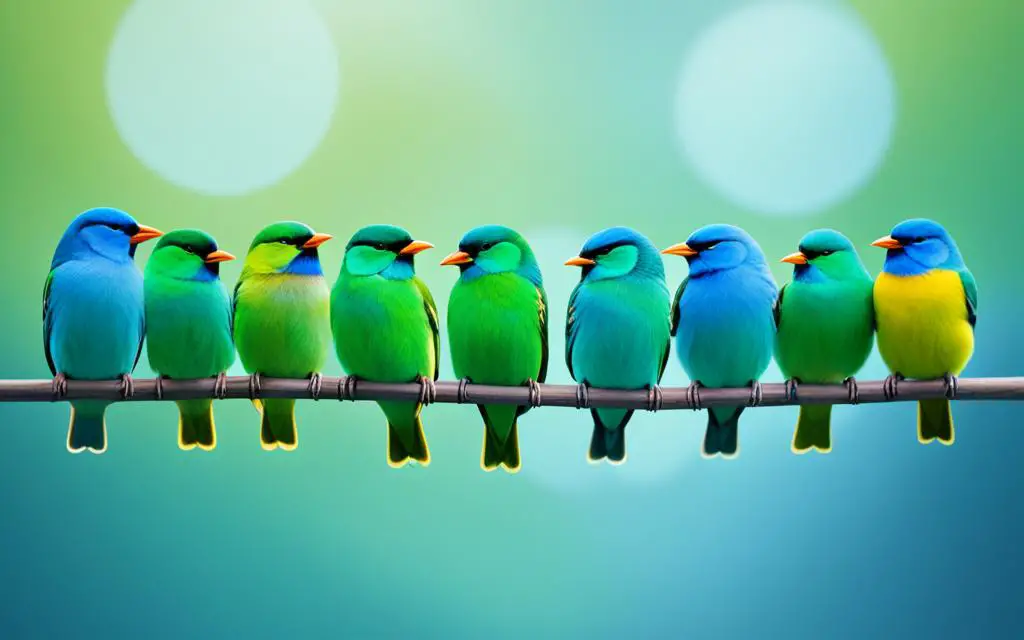
Remember, the importance of sleep for birds isn’t just about avoiding morning crankiness; it’s about overall vigor and vitality. Achieving the perfect harmony between bird behavior and sleep not only ensures a happy companion but also a healthy winged family member. Be their knight in shining armor by protecting their kingdom of dreams from the dragons of disruption.
| Sleep Disruption Factor | Impact on Birds |
|---|---|
| Ambient Outdoor Lighting | Can prevent birds from winding down and finding sleep |
| Late Night Television Noise | Keeps birds alert and disrupts their sleep patterns |
| General Household Commotion | Interferes with the bird’s sense of security, crucial for restful sleep |
Now that you have the night watch planned out, forget the nightcap for yourself, and instead ensure everything is whispers and lullabies in the aviary. Tomorrow, you’ll be thanked with the sweetest symphony of chirps rather than the solo of a grumpy bird. Night-night, don’t let the bedbugs (or should we say feather mites?) bite!
How Much Sleep Does a Bird Need?
If you’ve been wondering, “How much sleep does a bird need?” you’re likely noticing some feathers ruffled in ways that don’t quite scream ‘elegance.’ The truth is, your winged companions’ bedtime rituals are more demanding than you might think. We’re talking about creatures that need between 9 and 11 hours of nocturnal nirvana to keep their tweet tunes harmonious and their mood elevated.
Let’s talk about parrot sleep needs. Your vibrant parrot isn’t just a splash of color in your life; it’s a complex being with sleep demands that rival your own after a long day of being fabulous. Failing to provide those recommended twilight hours could transform your parrot from a chirpy cherub into a beaky beast faster than you can say “Polly wants a cracker!” And it’s not just about attitude adjustments; a poor sleep schedule can also lead to a weakened immune system, making your feathered friend more susceptible to sickness. So, let’s not ruffle any more feathers — ensure those birdie bedtimes are downright divine!
Understanding your pet’s sleep is critical, but remember, avian sleep patterns have a rhythm to them. The sleep cycle of your bird should be a smooth reggae beat gently leading into dreamland, not a jarring metal concert keeping them up all night. Consider how even a whisper of light from a street lamp or a sudden crescendo of late-night laughter can interrupt their slumber. It’s akin to your alarm clock deciding to throw a 2 a.m. rave—utterly unwelcomed!
Let’s present you with an image of tranquility—imagine your bird, nestled in, with nothing but sweet dreams on the agenda:
Now, to ensure you’re equipped to curate the perfect sleep haven for your feathery muse, let’s swoop into a detailed tableau capturing the essence of a bird’s ideal sleep sanctuary:
| Components of Good Sleep | Role in Avian Sleep |
|---|---|
| Darkness | Encourages natural sleep patterns and hormone regulation |
| Soundscape | A steady flow of quietude helps in achieving uninterrupted rest |
| Nesting | A cozy, secluded place enables a sense of security and peace |
| Consistent Schedule | Maintains the bird’s internal clock in sync with its natural rhythm |
So, dear bird aficionados, while you ponder the essence of avian sleep patterns, be the wind beneath your birds’ wings and guide them to dreamland unscathed by the foils of noisy neighbors, glaring bulbs, and surprise midnight snack expeditions. Because at the end of the day, a well-rested bird is a harmonious partner in the high-flying dance of life. Make the nocturnal countdown count, and let your birdie catch those Z’s in peace!
Does My Bird Need More Sleep?
Just like we can get cranky without our coffee or eight hours under the blankets, birds can turn into the feathered equivalent of a sleep-deprived grouch. The signs of sleep deprivation in birds are pretty vocal—literally. If your tweety bird is now the ‘lord of the squawks,’ it might be time to turn detective and decode the mystery behind their grumpy tweets.
Signs Your Bird May Be Sleep Deprived
Is your bird acting like it’s on a perpetual bad feather day? Keep an eye out for some telltale signs which scream, “I need more shut-eye!” If your once sociable bird starts nipping at your fingers or shunning your birdie talks, it’s time to pay attention. Here are some clear signs of sleep deprivation in birds:
- Increased nippiness or aggression
- A noticeable drop in energy and social engagement
- Disinterest in activities they usually enjoy
- Changes in vocal patterns: either too quiet or excessively loud
- Feather ruffling and restless behavior
It’s a bit like turning on the lights at 2 a.m. and expecting not to blink—it’s not going to happen. If you notice these changes, your feathered pal might be signaling for some serious snooze time.
Adjusting Sleep Schedules for Optimal Bird Health
Now that you’ve unearthed the signs, it’s time to switch on your benevolent ruler mode and help your bird sleep better. Creating a bedtime oasis free from the cacophony of the day is paramount. Think of it as setting up a five-star luxurious spa retreat for feathery clientele—they should wake up feeling refreshed, with all tail feathers accounted for!
To champion bird sleeping habits, you could:
- Introduce a consistent sleep schedule, just like a bedtime ritual for kids (minus the storybooks).
- Ensure their sleep haven is as tranquil as an abandoned library at midnight.
- Cozy up their cages with a blanket to shield them from vampiric electronic light.
- Consider noise levels—what seems like a mouse’s squeak to you could be a lion’s roar to them.
- Mimic the gentle whispers of nightime in the wild—peaceful, calm, surreal.
Not sure how to turn bedtime into a dreamy escapade? Ponder over this: if you were the size of a parakeet, wouldn’t you prefer a snuggly, dark nook, untouched by the roar of the human jungle around you?
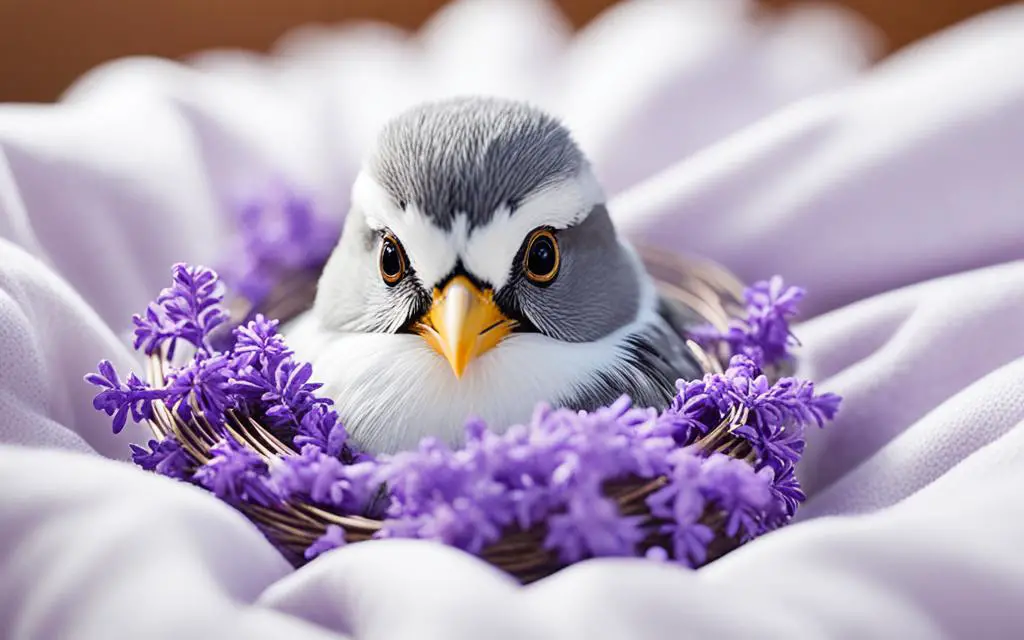
As you transform into a sleep maestro for your beaked companions, you’ll notice a profound transformation. That biting beak turns into chirpy pecks, and those sleepy eyes will glisten with vitality. Because in the end, everyone, even your bird, yearns for the euphoria that only comes with a seamless slumber under the stars—or in this case, the cozy nook of a safe, silent room.
The Impact of Disturbed Sleep on a Bird’s Behavior
Have you noticed your usually cheerful bird turning into a grumpy featherball? Much like a tot deprived of naptime, a bird that doesn’t get enough sleep may start to show clear signs of a tired bird. You know the drill – those early morning chirps now sound like an old door hinge in dire need of oiling, and playful pecks suddenly feel like a personal vendetta. This isn’t just birdie mood swings; it’s a cry for help in the language of squawks and fluffs. Let’s uncover what some shuteye snags might do to their chirpy spirits.
Behavior that veers towards the feisty side, or outright aggression, can often be sourced back to disrupted slumbers. Imagine being perpetually stuck on the grumpier side of the bed – that’s your bird’s reality when it can’t get those precious Z’s. Birds in this sleep-deprived state might become the feathered version of a Hangry Harry, with tendencies to be more nippy, and exhibit noticeable shifts to a more grumpy bird personality.
And while birds plucking at their feathers might seem like they’re just trying a new preening style, it’s more likely a signal of discomfort, stress, or being overly tired. It’s the equivalent of you tossing and turning, trying to find that sweet spot on your pillow. Alas, your bird’s pillow seems perpetually uncomfortable. Could it be that it’s longing not just for rest, but for a respite from endless disturbances?
But don’t just take my word for it; here’s a bird’s-eye view of what a night in unrest looks like:
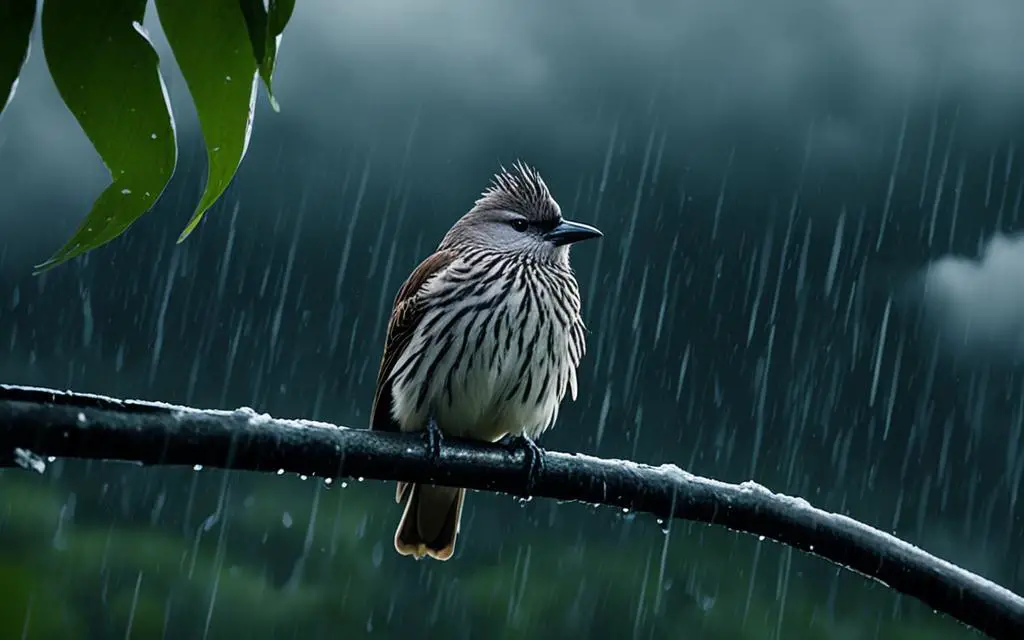
Let’s peck into a detailed breakdown of the typical behaviors exhibited by sleep-deprived beaky buddies:
- Does Polly want a cracker? Nope, she wants silence! A tired bird might ignore its favorite treats and toys out of sheer exhaustion.
- Similarly, that usually-bubbly parakeet turning into a wallflower? Could be a case of needing more dream time.
- Is your bird fluffing up more than usual or acting displaced? Better check if it’s catching enough winks away from the hustle and bustle.
And because we take our winged pals’ well-being seriously, here’s a neat little chart to help you jot down and observe any changes:
| Behavioral Sign | What It Could Mean |
|---|---|
| Nipping or biting | Your sweet bird might be turning into an aggressive bird due to lack of rest. |
| Feather ruffling and plucking | A stressed or anxious indication of missing out on sleep. |
| Reduced vocalization or lethargy | Too pooped to tweet – could be your bird was up all night counting sheep. |
These changes are birds’ unspoken pleas for uninterrupted snooze-fests. Pay heed to these sleepy signals to help your feathered friend stay atop their perch, both literally and figuratively. A happy bird is a well-rested bird, so let’s give them the peaceful pillow time they deserve and watch as birdie grumpiness turns into those delightful morning melodies once again!
Creating a Bird Sleep Environment for Restful Nights
As a responsible bird parent, you know that creating a good sleep environment for birds is akin to fluffing the pillows for a five-star snooze-fest. It’s not just about dimming the lights; it’s about promoting healthy sleep for your feathered friends. Now, let’s wing our way through the essentials of dreamland design, from peaceful bird cage location for sleep to choosing the cozy comforts that ensure your bird catches those Z’s with ease.
Optimal Bird Cage Placement for Sleep
You wouldn’t put your bed in the middle of a bustling train station, right? Well, our avian amigos crave quietude just as much. Select a snoozing spot away from the household hustle and bustle. A corner in a seldom-used room, away from the blaring TV and high traffic, might just be the sanctuary your beaky buddy needs. Plus, think about this: positioning their cage in a place where the morning sun gently invites them to rise could make a world of difference in their day… and yours!
Choosing the Right Sleep Accessories
Set the stage for uninterrupted slumber with the right ambience. A bird sleep cover can be the ultimate “Do Not Disturb” sign for light sleepers, turning their cage into a darkened retreat fit for avian royalty. And since spending hours on a rogue perch is worse for them than a bad mattress is for us, ensure the perch size is just right—your bird’s feet will thank you!
Now, perhaps you’ve heard of the magic of smaller sleep cages? Imagine a cozy nook, away from night-time disturbances, where your chirpy companion can curl up, undisturbed by the world. It’s like their own little room at a birdie B&B. Plus, let’s not forget to talk about location, location, location—placing that sleep cage in a tranquil spot? Chef’s kiss for birdie bedtime bliss.
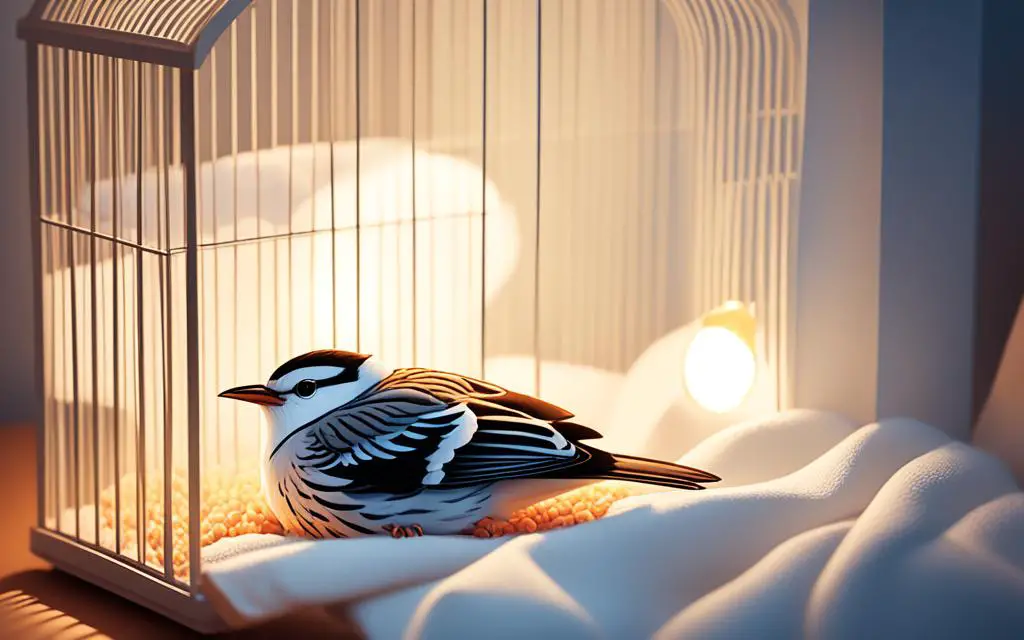
With our feathered friends, beauty sleep is more than just a catchphrase—it’s essential for their sunny disposition and vibrant health. So go ahead, fluff that cage and settle them into their sleep sanctuary because, in the end, a rested bird is a happy bird. Sweet dreams to your winged companions, may their sleep be as peaceful as a cloudless sky.
| Accessory | Benefits |
|---|---|
| Darkened Room or Sleep Cover | Provides the uninterrupted darkness essential for a good night’s sleep |
| Smaller Sleep Cage | Affords a personal sleep haven free from overnight disturbances |
| Properly Sized Perch | Prevents foot damage and supports natural resting posture |
Recognizing the Needs of Different Bird Species
So, you’ve brought the beauty of a bird’s melody into your home, but did you know that the harmony of their song is greatly influenced by how well they sleep at night? Adequate rest is not ‘for the birds’ – it’s critical for their well-being. Whether you’re a proud parrot parent or a fan of the more delicate finch serenade, understanding and catering to distinct bird sleep needs is essential for your avian orchestra to flourish.
From Parrots to Finches: Catering to Various Sleep Needs
Let’s fly through the importance of creating optimal sleep conditions for different feathered friends. Parrot sleep needs are renowned for being as complex as their vivid personalities. These intelligent creatures not only need plenty of z’s but also a nocturnal nook that’s free from the electric glow of human life.
Meanwhile, the sleepy needs of your cockatiel, although similar, tend to require a quieter symphony of surroundings to assure a night-time overture of peace. Perhaps you’ve observed your budgie yawning? Could it be a sign of sleep deprivation, considering that their tiny eyelids need to embrace the dark for a whopping 9 – 11 hours!
Species-Specific Sleep Requirements You Should Know
Just like our love for a good night’s sleep doesn’t adapt well to the life of an owl, neither do conure sleep needs align perfectly with that of lovebirds. For instance, lovebirds could teach us a thing or two about cuddling up for warmth and comfort when night falls. Finch sleep needs may include snuggling into a cozy corner standing side by side.
The delicate melodies that canaries bless us with by day are the result of the uninterrupted stillness they enjoy by night. Indeed, canary sleep needs resemble a fortress of solitude – think Superman’s lair minus the ice.
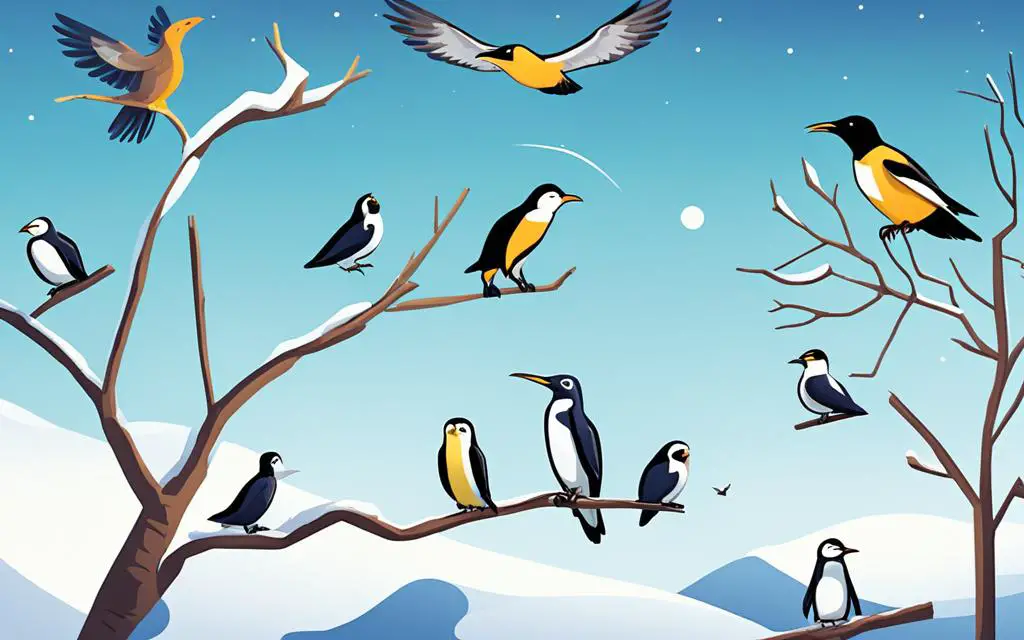
Whether your home is a backdrop to the rainbow dance of a parrot or the demure moves of a canary, the need for a sleep sanctuary is universal. Behold the art of tailoring sleep environments to suit each feathered performer’s needs:
| Species | Optimal Sleep Duration | Preferred Sleep Conditions |
|---|---|---|
| Parrots | 9 – 11 hours | Dark, quiet, and secluded area |
| Cockatiels | 9 – 11 hours | Tranquil space with minimal disturbance |
| Budgies | 9 – 11 hours | Calm environment, away from light pollution |
| Conures | 9 – 11 hours | Moderately silent with comfortable perching |
| Lovebirds | 9 – 11 hours | Intimate and secure, akin to nesting |
| Finches | 9 – 11 hours | Group sleep setting, sociable but not noisy |
| Canaries | 9 – 11 hours | Solitary and serene to uphold the canary opera |
Championing sleep for our avian friends is like crafting a lullaby tailor-made for their unique needs. It stretches beyond a simple light switch flick at dusk – it’s about maintaining rhythm in their routine that resonates with their innate preferences. And, as you tuck your winged wonders in for the night, remember that your compassion for their nocturnal needs is the truest serenade you can offer them.
Tackling Common Sleep Problems in Avian Companions
If your bird has been acting like a feathered outlaw at dawn instead of the usual chirpy charmer, it might be navigating through some common sleep problems. Tackling these nocturnal nuisances is key to restoring peace in the pecking order. Whether dealing with an overstimulated bird by day or coping with night frights during the wee hours, understanding and addressing their nocturnal needs can make a world of a difference.
For your diurnal bird sleep, ensuring that the sleep process is as natural and undisturbed as possible should be your night-time mission. And let’s not forget our nighttime carolers like owls, who take their daytime beauty naps seriously. Ensuring these nocturnal bird sleep patterns are met means they can continue to rule the roost—or tree—once dusk falls.
However, sometimes it’s not the lack of trying but a matter of an overstimulated bird grappling with a discotheque of environmental stimulants. And who can blame them? With your latest binge-watching saga reaching a climactic finale at 3 a.m., it’s a wonder how Polly hasn’t developed insomnia. Here, creativity in minimizing disruptions can save the day—or the night.
And speaking of saving the night, have you considered the restorative power of bird naps? Think of them as minuscule, feathery siestas; short but sweet intermissions to recharge those flight engines. In the world of winged wonders, a few artful naps can help counterbalance the chaos of common sleep problems in birds.
Now, let’s spread our wings and fly over some practical strategies to thwart those sleep stealers:
- Channel your inner Sherlock Holmes and track down the culprits of noise and light disturbances. Could it be the night light that’s pretending to be a midnight sun?
- Become a perch connoisseur, offering a smorgasbord of perch sizes and textures, promoting foot health and comfort—a happy bird foot equals a happy sleeping bird.
- Master the art of cage placement—tucked away from household traffic, your bird’s cage should feel like a VIP lounge at the quietest corner of your abode.
Don’t hesitate to transform the cage into a cocoon of calmness with an alluring bird sleep cover that whispers, “Welcome to dreamland.” As an aspiring ornithological sleep therapist, you’re on a quest to ensure your winged wizards have nights filled with nothing but the best dream sequences.
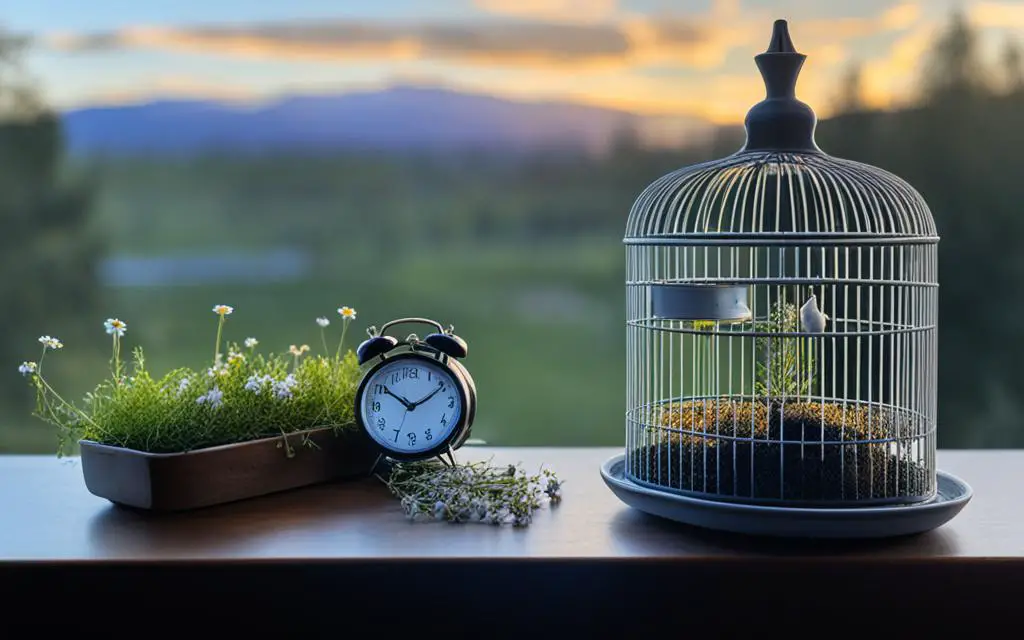
Remember, your avian amigos are counting on you not just for seeds and socializing, but for crafting a sleep sanctuary that rivals the fluffy clouds of their dreams. Making strides in solving common sleep problems will not only soothe your feathered friend’s sleep cycle but will also transform them back from grouchy gremlins to jubilant jewel tones of the sky.
| Problem | Nighttime Nuisance | Daytime Deliberation |
|---|---|---|
| Overstimulated Bird | Reduce environmental light and noise | Encourage calming activities before bedtime |
| Nocturnal Bird Sleep | Ensure a quiet, daytime sleep haven | Keep the cage covered and in a peaceful area |
| Diurnal Bird Sleep | Maintain a consistent night routine | Allow evening wind-down time |
| Bird Naps | Provide opportunities for brief daytime naps | Create a calming, nap-friendly environment |
With this arsenal of sleep support, be ready to see a transformation that’ll have your birdie basking in glorious, unfeathered joy – and you’ll finally get to see the early bird catch the worm instead of giving you the stink eye. Sweet dreams to your feathered family member – may their slumbers be as smooth as their sleek plumage!
Introducing Healthy Sleep Habits for Birds
As a discerning bird owner, you’ve probably heard the trills and chirps that signify a day well-spent in avian delight. But what about the silent song of night? Yes, we’re talking about sleep—the feathery realm of rest where the busy banter of beaks is replaced by the hush of deep breathing. To keep your feathery choir soaring high rather than snoozing snippy, it’s time to chirp about creating a relaxing bedtime routine for birds.
Imagine, if you will, a bird’s version of counting sheep—a steady calm floats through their habitat, and the sun dips below the horizon, cueing their little internal clocks that it’s time to tuck in those wings. This is where bird sleep routine harmony begins. And rest assured (pun intended), this concert of calm isn’t just for the stationary—it’s for the winged voyagers too. Travel and bird sleep needn’t be a cacophony of unfamiliar rustles and bustles.
Establishing a Sleep Routine for Your Bird
Creating consistency is like composing a lullaby that your bird hums each night. Establish a routine that echoes across the days and aligns with natural light patterns—sunrise to sunset. Now that’s music to your bird’s ears! Think about the comfort that comes with knowing what to expect. Your bird, the maestro of moods, thrives on predictability. Lower the final curtain of twilight at the same time each night, and soon enough, your bird’s internal symphony will be playing a sonorous sleep-time sonata.
Helpful Tips to Encourage Better Sleep for Your Bird
Let’s talk tips—a few feathers in your cap to help the birdie bed-down. Buffering against the evening cacophony with a cozy cover may just muffle out life’s louder aspects, which translates to bird stress and sleep taking a beak-to-branch stretch towards the tranquil. And while the idea of your parakeet in earmuffs to drown out nighttime noise is chuckle-worthy, considering a backdrop of natural, gentle sounds might be more on-key for their nocturnal concert.
And then there’s lighting—if your feathered friend is partying under a 24-hour glow, it may mistake the living room for the Vegas Strip. A bit of darkness is indeed as soothing to them as that heavy comforter feels to us on a chilly night. So tighten up that bird sleep routine with a day-night rhythm that’s as smooth as the feathers on your bird’s back.
Traveling? Birds, like seasoned jet-setters, also need their rest. A mobile sleep sanctuary—a sleep cage for their nomadic nights—keeps their sleep melody on track. So when the wheels start rolling, your bird doesn’t have to lose any sleep over it.
Moving on to auditory ambiance—bird noise and sleep are like two feathers on the same wing; they must complement each other for a full flight. A sprinkle of soft tunes or the susurrus of a white noise machine might just be the encore to their day.
Allow me to present a symphony of sleep suggestions in table form, ensuring your birdy badinage turns into blissful bedtime:
| Tip | Description | Benefits |
|---|---|---|
| Consistent Lights-Out Time | Turn off lights and reduce activity around the bird’s cage during evenings. | Syncs with the bird’s circadian rhythm; reduces stress |
| Cage Accessories for Sleep | Equip the cage with covers and proper size perches. | Creates a controlled environment favorable for sleep |
| White Noise | Introduce a white noise machine or play soft music at night. | Drowns out disturbances, offering a serene soundscape |
| Travel Accommodations | Use a dedicated sleep cage for familiar sleeping conditions while traveling. | Prevents sleep disruption due to changes in the environment |
| Daily Wind-Down | Engage in quieter, calming interactions as bedtime approaches. | Signals the bird that it’s time to rest, making sleep easier |
By now, you’ve nested some valuable tidbits to ensure your bird’s twilight song is composed of soft coos rather than ruffled feathers.
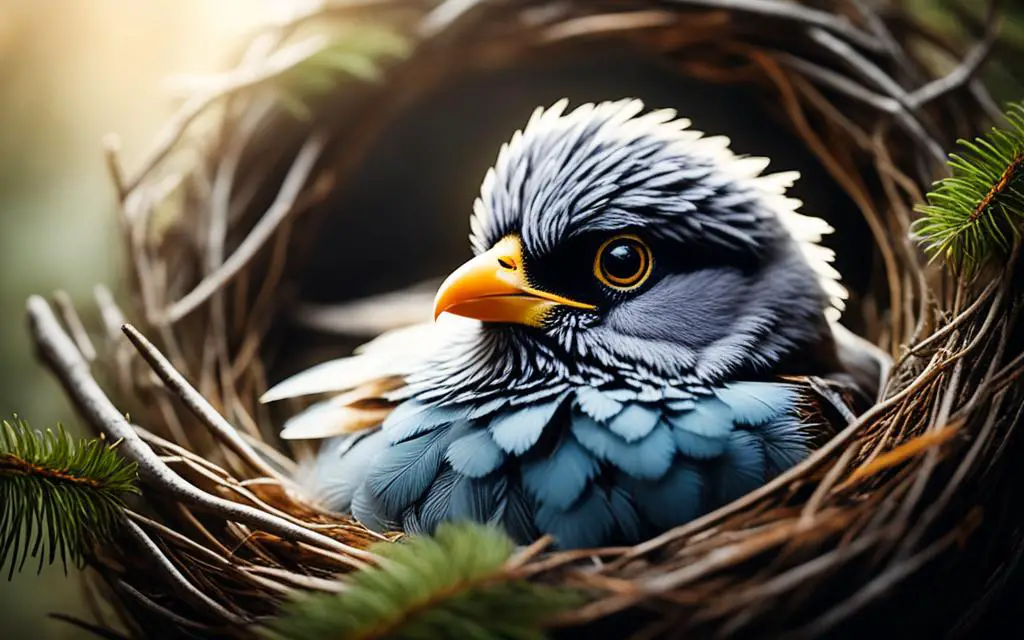
Remember, dear bird enthusiast, the night is a time of repose and dreams even on a perch. So, here’s to sweet dreams and serene nights, not just for you but for your fine-feathered companions as well.
The Science of Avian Sleep: How Birds Rest Differently
While you’re tucked in your cozy bed, your bird companion is experiencing a whole other world of sleep—one that’s beautifully bizarre and incredibly smart. Unlike humans, birds have a sleep cycle that lets them keep one eye open (literally) for any sneaky predators. Let’s fly into the fascinating realm of avian sleep, where both REM and Non-REM sleep play a role, and Unihemispheric Slow-Wave sleep keeps birds on alert even during their most vulnerable moments.
Understanding REM and Non-REM Sleep in Birds
Ever puzzled why your bird can snap awake at the faintest rustle? Well, our feathered friends divide their snooze time between REM (Rapid Eye Movement) and Non-REM sleep, but not quite like we do. Their REM sleep, the phase associated with dreaming in humans, is much shorter, making their ability to wake almost instantaneous. As for Non-REM sleep, it’s the deep, restful phase where the bird’s body rejuvenates, but even then, they remain ready to flutter away at a moment’s notice.
Exploring Unihemispheric Slow-Wave Sleep in Avian Species
Hold onto your binoculars, bird enthusiasts, because the avian world’s sleep wizardry doesn’t stop there. We’re talking about Unihemispheric Slow-Wave Sleep, an extraordinary adaptation where one half of the bird’s brain dozes while the other half stays alert. This impressive ability allows birds to literally sleep with one eye open, ensuring that any potential predators creeping about couldn’t possibly prepare a midnight snack out of them.
A little bird might’ve told you that light and darkness are crucial in signaling to our winged pals when it’s time to hit the hay. But did you know that their circadian rhythms—internal clocks just like ours—are fine-tuned by nature’s light show? Whether it’s the setting sun or the glow of dawn, birds naturally know when to drift into dreamland or chirp their morning tune.
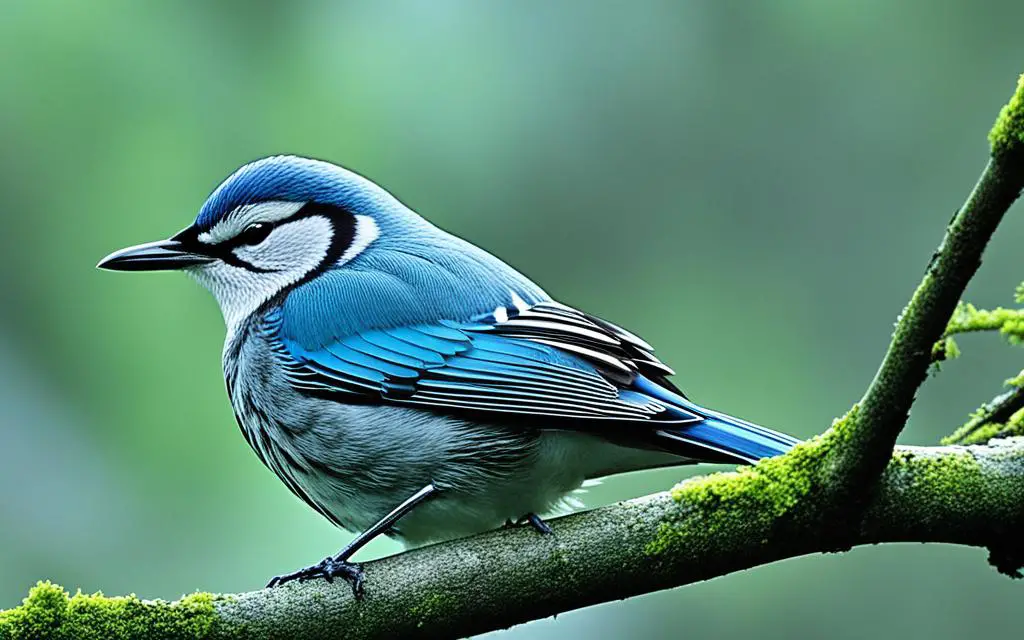
So, the next time you see your bird standing on one leg and closing one eye, don’t just chuckle at its funny pose. That’s some serious survival skill on display—half-asleep and half-awake, ready for whatever the night might bring. No night light and bedtime story needed for these expert snoozers!
Factoring in Light Sensitivity When It Comes to Bird Sleep
Just as closing curtains can invite a snooze-fest for us night-owls, factoring in light sensitivity and bird sleep is crucial for our feathered friends. That uncanny ability birds have to wake up chirping at the crack of dawn is all thanks to their light-sensitive internal clocks. So, if your loveable parakeet is more night-ghoul than morning-lark, it may be time to consider its exposure to light. With bird breeding season and sleep patterns inextricably linked, managing that glow can mean the difference between a house of harmonious tweets and a cacophony of cranky chirps.
Introducing adjustments for changing daylight hours and bird sleep could just be your ticket to ensuring that Tweety hits those high notes at the break of day, and not in the middle of your late-night movie marathon. Think of it as setting the mood — less ‘Midnight in Paris’ and more ‘Midwinter Night’s Dream’ as you craft a twilight oasis that respects their natural sleep-wake cycle.
But how do you manage this feat without living in perpetual darkness or missing your favorite TV shows? Here’s a little bird whisperer secret: timed lights and darkening blinds. Yes, these nifty inventions aren’t just for setting the scene for a romantic evening or hiding from that overly enthusiastic door-to-door salesman — they’re also perfect for emulating those longer winter nights that our birds so desperately crave.
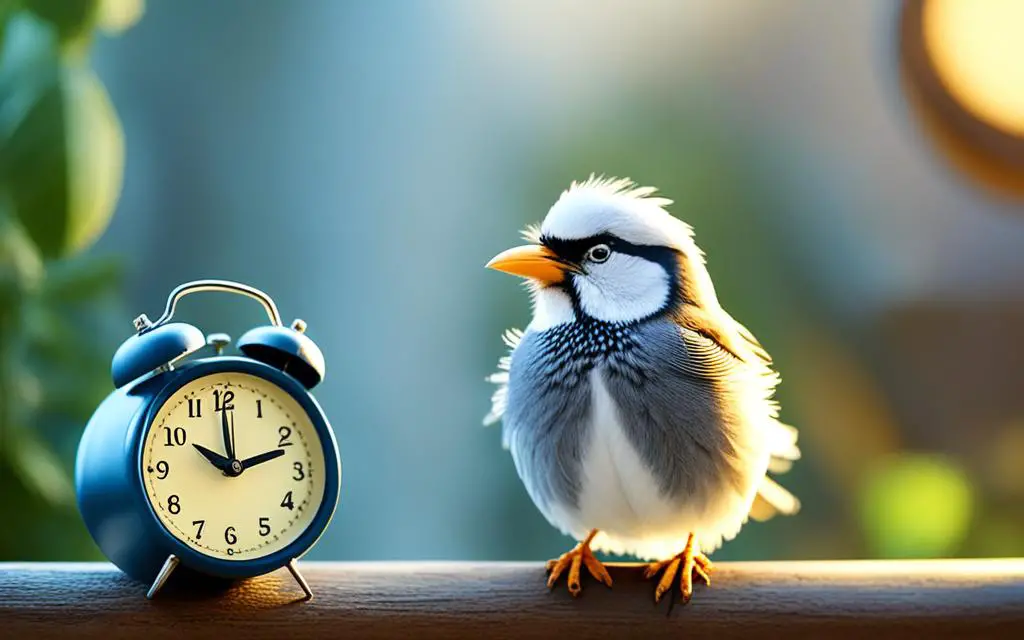
Now, don’t be ruffled if you’re feeling a little overwhelmed. The nuts and bolts of creating a consistent environment that honors both light sensitivity and bird sleep have been conveniently plucked and laid out for you. From adjusting light schedules to fostering a harmonious habitat, you can wing it like a pro. See below:
| Strategy | How It Supports Bird Sleep | Additional Benefits |
|---|---|---|
| Timed Lighting Systems | Mimic natural sunrise and sunset inside | Regulates breeding cycles, enhances overall health |
| Darkening Blinds/Covers | Replicates longer nocturnal periods, especially in winter | Prevents early wake-up calls from urban lighting |
| Dimmer Switches | Gradual light reduction doesn’t startle or confuse birds | Creates a soothing ambiance for evening relaxation |
| Reducing Screen Time | Minimizing ambient light from TVs and gadgets before bedtime | Lessens the chance of disrupting the bird’s natural sleep onset |
| Red Spectrum Lighting | Less disruptive to sleep compared to blue spectrum light | Can potentially aid in managing seasonal affective disorder in birds |
By feathering your nest with these sleep-supportive strategies, you’ll tickle the fancy of both light-sensitive beaked sleepers and those bound by the needs of the bird breeding season. So dim those lights, draw those blinds, and let nature (and technology) work in tandem to ensure your bird gets the blissful slumber it needs.
Conclusion
As the sun sets and the moon claims the sky, there’s a peaceful silence that both you and your feathered companion deserve to embrace. The quest for ensuring quality bird sleep is not a fickle fancy—it’s a cornerstone for bird health and happiness. From dusk till dawn, their rest is as important as their zest for life during the daylight. Let’s feather the nest with some final tidbits and ensure that your avian ally gets all the ZZZs for soaring high the next day.
Embracing the Quiet: Ensuring Your Bird Gets the ZZZs It Needs
Creating a quiet nighttime environment isn’t about tiptoeing around as though your floors are rigged with birdie booby traps—it’s about understanding and respecting the needs of your nocturnal orator. Observing your bird’s sleep behavior is like being a nature detective; look out for signs of restlessness or nippiness, which could be coded chirps for “Hey, I need some solid shut-eye here!” And when the beak opens wide not for a song but a yawn, it’s time to dial down the decibels and dim the lights for dreams of uncharted skies.
Implementing Strategies for a Healthier, Happier Bird
Tackling the night-time symphony doesn’t have to be a solo act. There’s no shame in reaching out and consulting an avian veterinarian if your wingman seems more akin to a night-owl than a daytime diva despite the sleepy setup. A professional feathered-friend physician can rule out ornithological oddities and provide personalized advice to promote the best slumber party in town. Plus, they’re great for confirming that your bird’s snooze isn’t losing its groove due to underlying health concerns. Regular vet checkups become a ritzy routine to ensure any sleep-related quirks don’t go unnoticed.
In the tranquil theater of the night, where the whispers of winged serenades await, your role in ensuring quality bird sleep becomes the most starring part. Here’s to your commitment to their rest—because after all, the best wake-up call is the one that comes after a night of peaceful, uninterrupted dreams. Goodnight, sleep tight, and don’t let the nightjars bite!
FAQ
How much sleep does my bird need?
What are the signs that my bird isn’t getting enough sleep?
How can I create a conducive sleeping environment for my bird?
What sleep-related behavior changes should I watch for in my bird?
How do I adjust my bird’s sleep schedule?
Are there specific sleep requirements for different bird species?
What strategies can I use to ensure my bird gets adequate sleep during travel or routine changes?
How does light sensitivity affect bird sleep?
What should I do if my bird has consistent sleep problems?
Source Links
- https://www.birdcagesnow.com/blogs/bird-blog/how-much-sleep-does-my-parrot-need
- https://birdsupplies.com/pages/how-much-sleep-does-my-parrot-need
- https://birdtricksstore.com/blogs/birdtricks-blog/how-much-sleep-does-my-parrot-need

My name is Shane Warren, the author behind Your Bird Buddy – your ultimate guide to the wonderful world of birds! Unleash your inner avian explorer as we delve into a vibrant library of knowledge dedicated to all things feathered. From learning about diverse bird species from across the globe to understanding their captivating habitats and behaviors, I’m here to fuel your passion for these magnificent creatures. Not only that, but I also provide valuable insights on being a responsible and informed pet bird owner. Join our vibrant community and let’s celebrate the feathered wonders of the world together – one chirp at a time. And be sure to join our Your Bird Buddy Community over on Facebook!

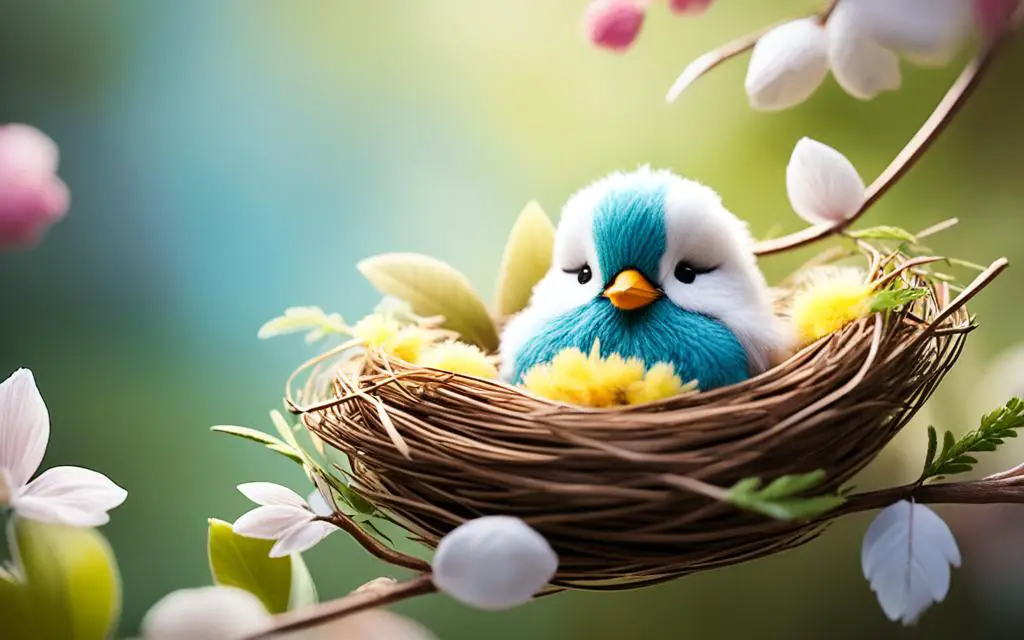
Comments are closed